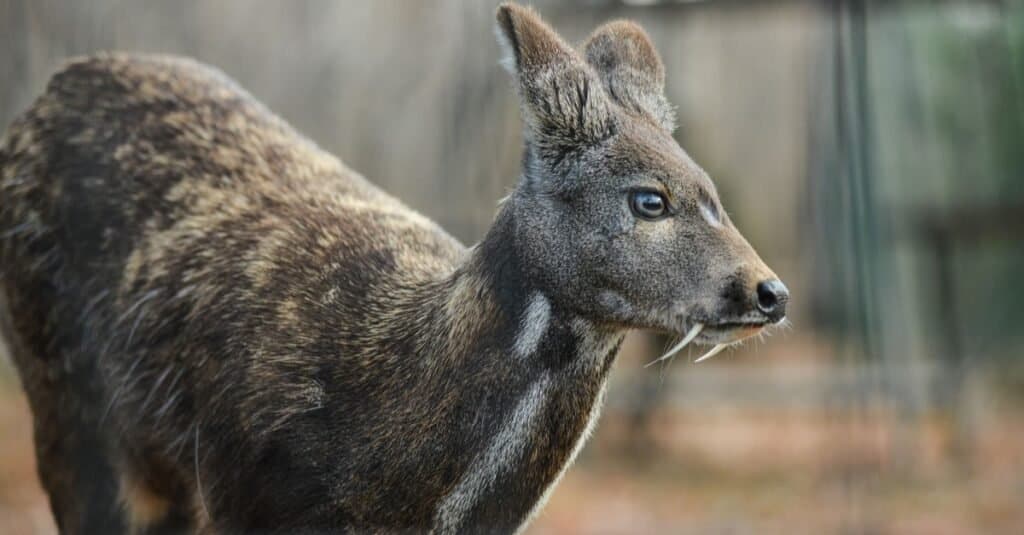Musk Deer
Moschus moschiferus
The glands of a musk deer can sell for up to $45,000 on the black market.
Advertisement
Musk Deer Facts
- Name Of Young
- Fawn
- Group Behavior
- Solitary
- Fun Fact
- The glands of a musk deer can sell for up to $45,000 on the black market.
- Biggest Threat
- Hunting by humans for musk glands.
- Most Distinctive Feature
- Fang-like tusks.
- Distinctive Feature
- Musk glands and fang-like tusks in males.
- Gestation Period
- 185-195 days
- Litter Size
- 1-2
- Habitat
- Forested hills, alpine scrub lands
- Predators
- Lynx, wolverine, yellow-throated marten
- Diet
- Herbivore
- Lifestyle
- Nocturnal/Crepuscular
- Favorite Food
- Leaves, grasses, flowers, mosses, lichens
- Common Name
- Musk deer
- Special Features
- Musk glands and fang-like tusks in males
- Number Of Species
- 7
- Location
- Asia
Musk Deer Physical Characteristics
- Color
- Brown
- Grey
- Skin Type
- Fur
- Lifespan
- 10-14 years
- Weight
- 15-37 lbs.
- Height
- 20-28 in.
- Length
- 31-39 in.
- Age of Sexual Maturity
- 15.7 months
- Venomous
- No
- Aggression
- Low
View all of the Musk Deer images!
Interesting Fact
“Humans hunt this deer to use its musk in expensive perfumes.”
Musk Deer Summary
These are small deer with fang-like tusks that is native to Asia. It is a shy, nervous, and solitary animal. Males produce a strongly scented fluid during rutting (mating) season. Throughout history, this species has been hunted to harvest this musk for use in manufacturing expensive perfumes.
Musk Deer Facts
- Musk deer lack antlers but have fang-like downward-pointing tusks.
- The strongly scented fluid males produce during mating season is used to manufacture expensive perfumes.
- Musk deer are a solitary, shy, and nervous species.
- They sleep in hollows scraped into the ground.
- There are seven species of musk deer, and all are endangered and decreasing in numbers.
Musk Deer Scientific Name
There are seven species of this deer. One species is the Siberian musk deer: Moschus moschiferus. “Moschus” is a Latin word meaning “musk” and “moschiferus” comes from Latin roots meaning “musk” and “to carry.” This species is part of the Mammalia class and the Moschidae family. Although musk deer are called “deer” their family is closely related to Bovidae, which includes antelopes, cows, sheep, and goats.
The other species and their scientific names are:
- Alpine musk deer – Moschus chrysogaster
- Anhui musk deer – Moschus anhuiensis
- Black musk deer – Moschus fuscus
- Dwarf musk deer – Moschus berezovskii
- Kashmir musk deer – Moschus cupreus
- White-bellied musk deer – Moschus leucogaster
- Siberian musk deer – Moschus moschiferus
A common name sometimes used for all species of musk deer and water deer is “vampire deer” because of the distinctive fang-like tusks of the males.
Appearance
Unlike true deer, the musk deer lacks antlers. Instead, like the Chinese water deer, the males have enlarged upper canines that grow into curved downward-pointing tusks that look like fangs. These grow throughout their lives and can reach four inches in length. Males also have a musk gland in a sac near the genitals that they use to spread secretions as signals to other males.
This animal is small and stocky. Their size ranges from 31-39 inches long and 20-28 inches high at the shoulder, and they weigh between 15 and 37 lbs. They have long, powerfully muscled hind legs with shorter, weaker, and thinner forelegs. Their backs are arched, which allows them to launch into jumps powered from their hind legs, like rabbits.
They have large ears, a short tail, and, unlike other deer, a gall bladder. At birth they have short, soft, dark brown hair with yellowish or white spots. At two years old they molt into their adult winter coat, with grayish brown fur and long, coarse, and brittle hair. The spots disappear or become less obvious in adults.
Their hooves are long, wide, and pointed, giving them extra surface area to keep them from sinking in soft ground and snow, and helping them get traction when climbing in rough mountainous terrain.

Male musk deer have enlarged upper canines that grow into curved fang-like tusks.
©Suvorov_Alex/Shutterstock.com
Behavior
This is a highly solitary and shy nocturnal or crepuscular (active during twilight) species. They migrate only over short distances. Due to their solitary nature, they do not form herds. When faced with a threat, they run away, hopping with powerful back legs that are longer than their front legs.
Males build “latrines” by gathering fallen branches and vegetation into a circle and wiping musk secretions on them to mark their territory. Researchers are able to use these to help them identify musk deer ranges, population numbers, and their preferred habitats.
Musk deer can climb inclined tree trunks up to 13 feet above the ground to get to lichens to eat in the winter.
Habitat
The various species live scattered across Asia, including Russia, China, Mongolia, Korea, India, and Nepal. They prefer hilly forested and alpine scrub mountainous landscapes remote from human settlements. The Himalayas are a particularly conducive habitat for them.
They like to stay in the middle latitudes, not above 5,250 ft. In the winter, they migrate toward steep slopes covered with coniferous forests, especially areas with rock outcroppings that can protect them from weather and predators. In the summer, they wander down to grassy forest river valleys with mixed coniferous and deciduous forest. Unlike the Chinese water deer, which they resemble, they do not like marshy areas.
Paleontologists know that this species once ranged across North America, Europe, and Asia, but they have become extinct everywhere except remote areas of Asia.
Diet
These deer are herbivores, eating over 130 different plant species of leaves, flowers, grasses, mosses, and lichens. They prefer easily digestible, nutritious foods that are rich in protein and low in fiber. In the winter, their diet includes coniferous needles, leaves, buds, tree bark, and honeysuckle. In summer, they prefer buckwheat, geranium, various grasses, and spirea.
Predators, Threats, and Conservation Status
Their natural predators are the lynx, wolverine, and yellow-throated marten. However, humans have historically been the greatest threat to them. Human population growth has led to deforestation and loss of habitat for this species. However, the greatest threat has come from hunting.
For over 5,000 years they have been hunted nearly to extinction to obtain the scent glands of the male, which are used in Asian traditional medicine and to produce expensive perfumes. Musk deer glands are one of the most expensive animal products in the world. They can sell for as much as $45,000 per kilogram on the black market. However, since each deer produces only 28 grams of musk at a time, obtaining a whole kilogram may require killing 36 deer. It is estimated that from 1999-2000 over 50,000 musk deer were killed by poachers.
Hunting musk deer is now illegal in China, Mongolia, and South Korea, although trade in musk deer products is allowed. In Russia, some regions permit hunting with a license and within quotas, while in other areas hunting musk deer is illegal. Because these restrictions are rarely enforced, they have not improved their conservation status. In Russia and China, musk deer have been domesticated and farmed to allow the extraction of musk without killing the animal. However, the amount and quality of musk collected has been inferior, so hunting is still preferred by those who trade in musk.
In 2016, the Korean company Sooam Biotech was reportedly trying to clone the Siberian musk deer to help preserve the species from extinction.
Reproduction, Babies, and Lifespan
During the rutting (mating) season, males actively mark their territories and use their tusks to fight one another for mates. The territory of one male may overlap the feeding grounds of several females.
Females become sexually mature at about 15.7 months. The mating season starts in December and usually lasts three to four weeks. The gestation period ranges from 185-195 days. In the months of May and June Females usually give birth to one fawn, but on occasion, will give birth to twins. The young are tiny and remain as motionless as possible during their first month to help them stay hidden from predators.
One unusual behavior of the female is that while her fawn suckles, she lifts her hind leg, which the fawn touches with its foreleg. This gesture is sometimes seen in courtship among other hoofed animals.
Siberian musk deer can live up to 20 years in captivity. The average age in the wild is estimated at 10-14 years.
Population
The population of all species is unknown, but the Siberian musk deer is estimated to have only 230,000 specimens remaining in the wild. All varieties in China may number 300,000+.
Similar Animals to the Musk Deer
- Chinese water deer – The Chinese water deer is similar in size and appearance to the musk deer, and the males of both species have fang-like tusks instead of antlers. However, the musk deer prefers forested areas while the water deer likes marshy areas near rivers.
- Sambar deer – The sambar is much larger than the musk deer, but it occupies a similar range in the foothills of the Indian Himalayas, has similar coloration, and is nocturnal or crepuscular.
- Ibex – The ibex is not a deer but is a member of the Bovidae family. The ibex is found in similar mountainous Asian habitats as the musk deer and has a similar diet.
Related Animals:
View all 164 animals that start with MMusk Deer FAQs (Frequently Asked Questions)
What is special about the musk deer?
Musk deer are different from other deer because they do not have antlers; instead, the males have fang-like tusks. They also have musk glands they use to mark their territories. In Asia, these glands are used in traditional medicine and to manufacture expensive perfumes. This has led to over-hunting of this species.
What is deer musk?
Deer musk is a strongly scented secretion of the glands of the male musk deer. It is used to mark territory and signal other males. It is also valued in traditional Asian medicine and as an ingredient in very expensive perfumes.
Where is musk found on the musk deer?
Only male musk deer have a musk gland. It is found in a sac between the genitals and the naval.
Thank you for reading! Have some feedback for us? Contact the AZ Animals editorial team.
Sources
- Wikipedia.com, Available here: https://en.wikipedia.org/wiki/Musk_deer
- Britannica.com, Available here: https://www.britannica.com/animal/musk-deer
- EOL: Encyclopedia of Life, Available here: https://eol.org/pages/328320/articles
- Science Direct, Available here: https://www.sciencedirect.com/science/article/abs/

















